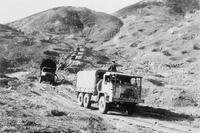When my dad was in college, he took a Pennsylvania history class, prompting him to delve into family history and genealogy. This is what he learned: His Great-Uncle Wally had served in World War I in France. There was a monument to his regiment and division in a small town "over there." He had been 18 when he served as a soldier for the U.S. Army.
Along with Uncle Wally's Army-issued shaving kit and doughboy helmet, that was the entirety of it.
Uncle Wally and his wife, Aunt Mabel, never had children, and they treated my dad and his brother to popsicles and color TV, stories and treats. Their home was neat and tidy, welcoming and friendly, and my dad loved them both for it.
But like many who have witnessed unspeakable carnage, Uncle Wally didn't talk about his heroics and experiences -- which were already half a century past when my dad knew him as an old man.
Uncle Wally's service had been family lore. And the monument -- erected somewhere in a small town in France -- loomed large in my imagination. My dad didn't know the name of the town.
Perhaps Uncle Wally didn't, either.

As a kid, I imagined traveling -- going town by town -- until I found the provincial monument in the town square, surrounded by flowers, perhaps, from adoring Frenchmen who never forgot their American saviors.
When my father retired from a lifetime of teaching band to elementary school students, his schedule suddenly opened. He sat down at his computer, and within a few days, he had unspooled a decades-long family mystery.
It turned out that Uncle Wally had served in World War I in France. But not only had he served in one of the deadliest offensives in World War I, he had served in the largest and second-deadliest campaign in American history.
The Meuse-Argonne offensive sent 1.2 million American soldiers to the Western Front, the last -- and bloodiest -- push to end the war. It gave Americans a hero in Sgt. Alvin York, made "Verdun" synonymous with "total destruction" and spared future President Harry S. Truman from a battlefield death.

From Sept. 26 to Armistice Day, 47 days, American, British, Belgian and French soldiers threw themselves at the German Army, slowly pushing east and north, and eventually breaking through the Hindenburg Line. Every inch was paid for in blood, with 350,000 casualties, military and civilian alike, when all was said and done.
Among the dead were 26,277 American soldiers.
But not Uncle Wally.
Uncle Wally would come home, live a peaceful life in a peaceful Pennsylvanian town, marry a kind woman and die an old, old man, having cheated death as a teenager in smoke-choked France.
France wears scars from its wars. As we waited for the bullet train in the Gare du Nord, plaques braced to the walls of the train station acknowledged the thousands of Jews who were deported by French police to their nearly inevitable deaths during World War II. As we buzzed by the French countryside, towns razed by two wars and then rebuilt flashed by the windows. Our stop on the TGV -- France's high-speed train -- was Gare du Meuse, the name of a river more regularly associated with apocalyptic battles than peaceful waterways.
After linguistic wrestling with a bus driver over tickets, we traveled another 30 kilometers to Verdun. On a two-lane country road, we passed through small towns clustered with stone homes and dotted with free-range chickens. The land appeared wide and flat and expansive, making it easy to imagine the advance of a war machine, churning over otherwise bucolic fields.

Gare de Verdun welcomed us with banners depicting its post-World War I cityscape, as well as the one 100 years later. After a long walk to a car rental place and negotiations over a van, the six of us, my parents, two sisters, husband, and myself, clambered inside and began our drive to Montfaucon-d'Argonne.
This article originally appeared on The War Horse.
Joanna Guldin-Noll lives in Central Pennsylvania with her husband, John, who served in Afghanistan from 2012-2013. Joanna has worked in the public, private and nonprofit sectors and has been published by digital and print publications, including Urbanite, The Huffington Post, and Military Spouse. Currently, she is the social media manager at Monster for Military.com.
Want to Learn More About Military Life?
Whether you're thinking of joining the military, looking for post-military careers or keeping up with military life and benefits, Military.com has you covered. Subscribe to Military.com to have military news, updates and resources delivered directly to your inbox.















